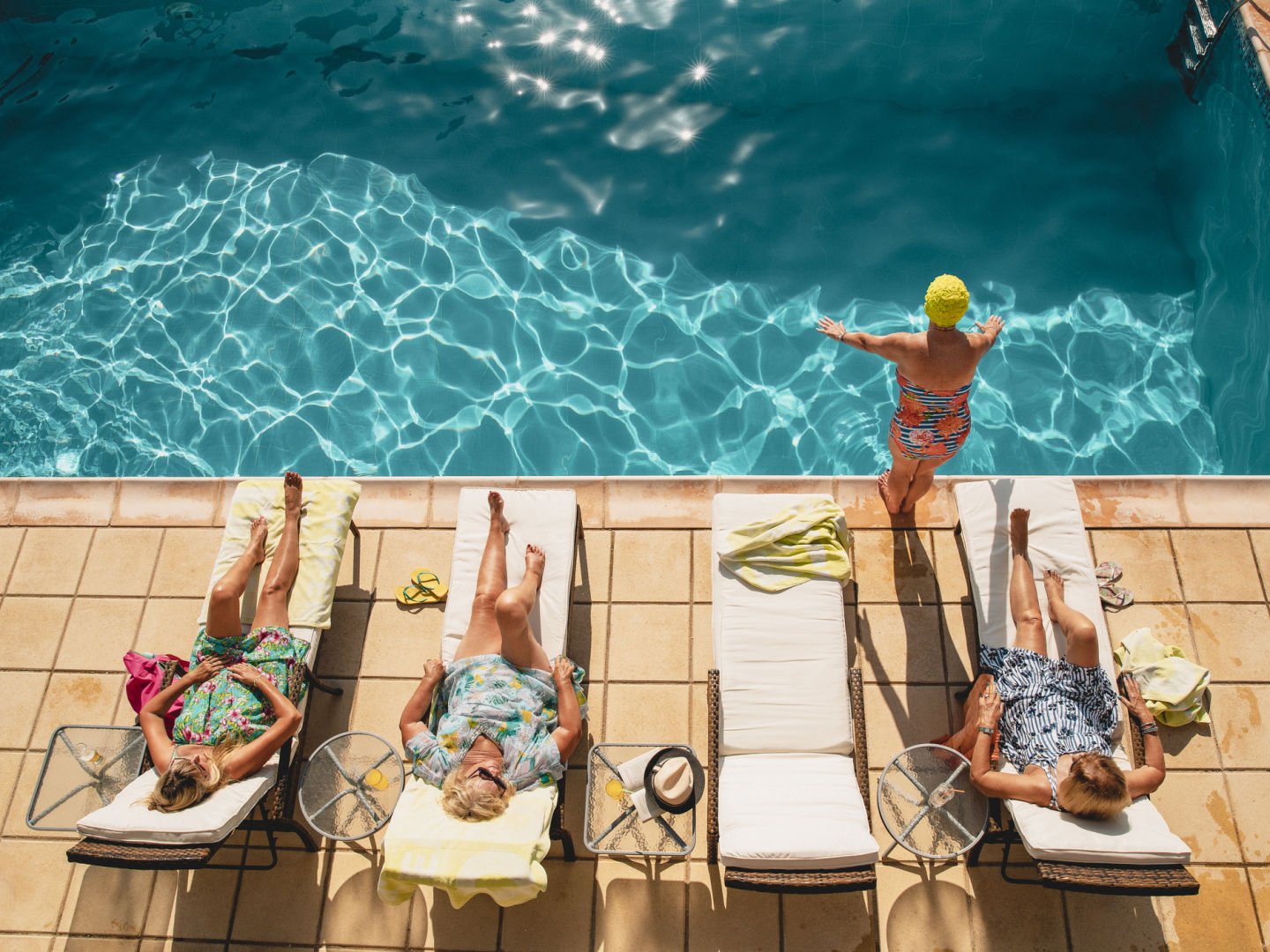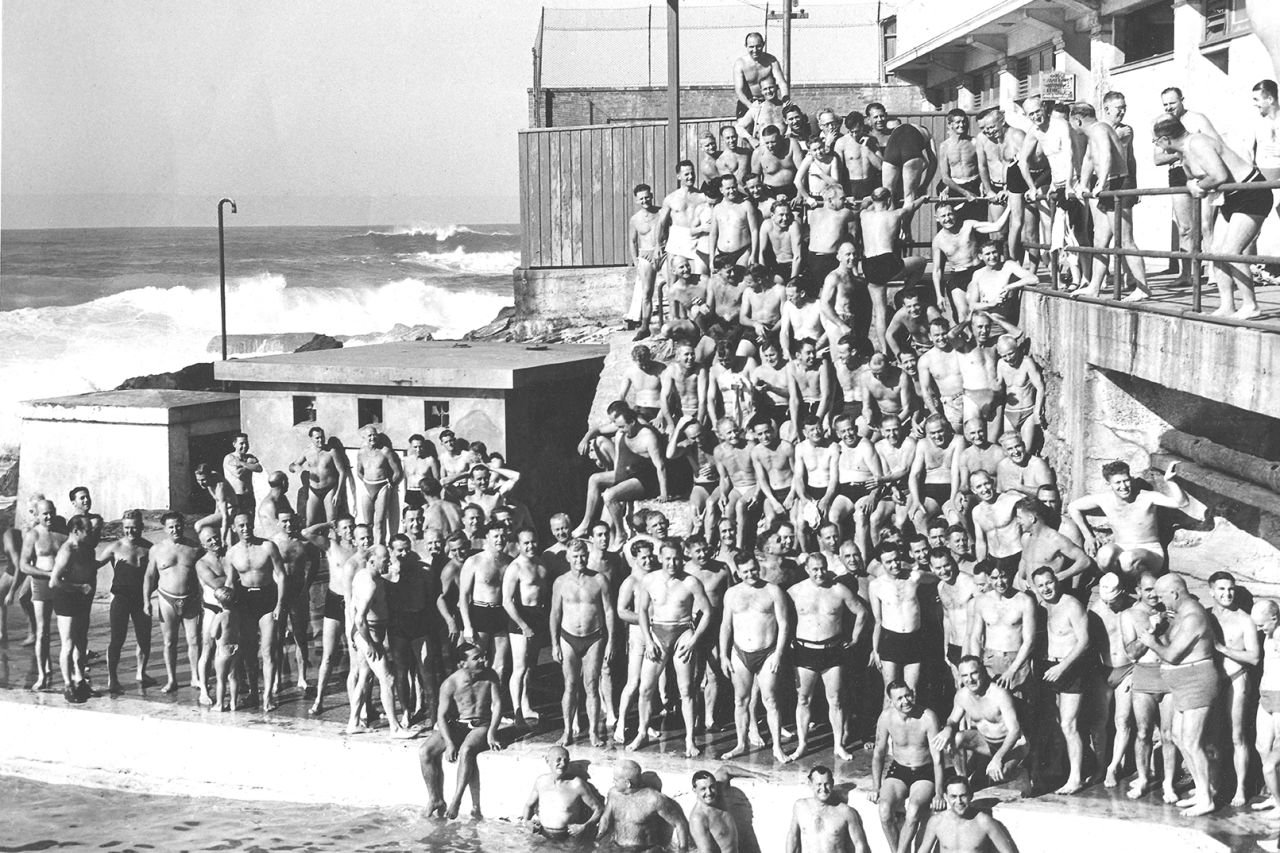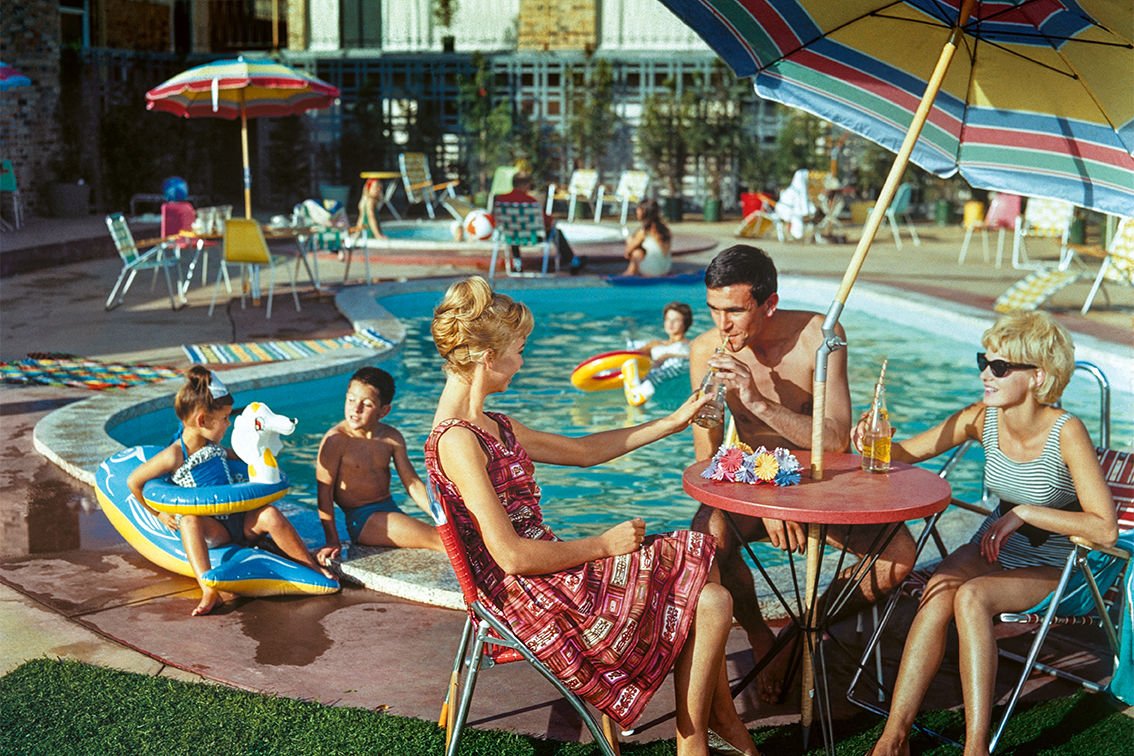Dive in: The evolution of the great Aussie pool
Many of us have fond memories of paddling in backyard, hotel, or public pools as children, and with our own children and grandchildren. How has this beloved feature of the Australian summer changed over the years—and are its days numbered?
By Amara Motala

As a child, a backyard pool was everything I ever wanted. I was envious of friends who were lucky enough to have their own pool sand loved the time that I spent there. But the best outings by far were to the public pool. This was a weekend favourite for me and my younger brother. He enjoyed the lap pool while I preferred the kids’ play area, complete with giant mushroom water fountains and spiral waterslides.
The peak experience of my childhood summer memories was the pool side birthday party. Every now and again, one of the lucky ones in my group of friends would succeed in begging their parents for a pool party. Given the run of the pool for a couple of hours on a Sunday afternoon, we broke all the rules—running around the signs that clearly stated 'NO RUNNING', dive-bombing in the shallow end and other shenanigans.
Public pools were also a great place to learn how to swim—a prerequisite for living in Australia. I was young when my family moved to Australia, and teaching us how to swim was at the top of my parents’ priority list. We would go for weekly swimming lessons at school and then practise at the local pool on weekends and school holidays.
Almost every Aussie has childhood memories like this from times spent in the pool, whether it was a public pool, hotel pool or backyard pool. In this country of golden summers and sweltering heat, pools hold a special place in all of our memories.
When my parents decided to buy a house with a pool when I was 10 years old, I was elated. In my mind, this was my ticket to summer time fun—I could go swimming whenever I wanted, and I could be that cool friend who had everyone over for pool parties(no matter that my birthday was in autumn).
I spoke with Jacquelyn (49), who shared fond pool memories from her childhood.
“I associate that time with being young and carefree, spending all day in the sun (before we knew that was less than ideal), eating icypoles while we swam, wrestling on Pool Ponies, the smell of coconut-scented tanning oil, and feeling our skin prune from hours of being in tepid salty water. Teamed with summer holidays, there were no rules, no homework, and no enforced time to get out, have a bath and go to bed. They were halcyon days!" she recalls.
“I spent a great deal of time at my cousins’ place, as they were the first family we knew with a pool. I remember spending much of my summer holidays playing Marco Polo and other made-up games in that pool. If you were an adult within earshot, you’d be forced to watch us perform handstands or made to judge diving competitions. We’d jump in first thing in the morning and would swim all day and well into the evening, our cheeks and noses pink from the sun and our eyes red from chlorine.”
Jacquelyn’s childhood changed when her family finally did get a pool.
“It was like being a local celebrity. If you had a pool your house was THE place for all the neighbourhood kids to converge. These days parents would be frantic at the idea of a dozen children jumping around in your pool unsupervised, but back then it was just the done thing. I do remember my parents giving me a huge speech about the dangers of playing near the skimmer box. ‘A girl died from being sucked into a skimmer box,’ they cautioned me. ‘If your hair gets caught it will pull you in, so DO NOT go near it.’ I was suitably terrified and kept well clear of it. I’m not sure this was real but it certainly had the desired effect.”
For those who didn’t have a pool in their backyards growing up, sunny days were full of longing and envy. Australian summers are notoriously hot, and, before the introduction of air-conditioning in every suburban home, going for a dip in the pool was the quickest, easiest, and most enjoyable way to cool off.
In the absence of their own private pools in their backyards, Aussies began to congregate at public pools.
Jacquelyn remembers this time fondly.
“My primary school had a public pool within walking distance, so during spring and summer we had regular swimming lessons throughout the week. Most families attended private swimming lessons at the pool as well, as they were quite inexpensive and were part of the social sport landscape in our area. I enjoyed swimming lessons but the real drawcard was the pool canteen. Once your lesson was finished you could score a bag of lollies and an ice-block for loose change.
Public pools became meeting places, places where people of all backgrounds came to cool down. Sweltering under the Australian sun was a universal experience, and public pools were a universal cure. They started having small cafes or barbecue facilities alongside tables, benches, and grassy picnic areas, making them the perfect place to hang out.
This sense of community gathering in swimming facilities culminated in ocean pools. For those who want to experience the ocean without battling the tides, ocean pools provide the perfect solution—safe than the waves but more exhilarating than the ordinary public pool, they are the perfect in-between.
Although less popular now, when a trip to the beach is more about getting into the actual ocean, many ocean pools still exist in Australia. The majority of these exist along the coastline of New South Wales, and a lot of them are well-loved fixtures in their communities.
Of course, this solution to a pool-less backyard is only available to those living near the coast.
For those in regional or remote areas, having a pool was a luxury that many simply could not afford. There, with the lack of access to the ocean (and therefore ocean pools), public pools were the only solution to this deficit. Even then, these were (and still are) few and far between.

Public pools are scattered throughout the heart of inland Australia, but they are few and far between. Those that are there are loved by the communities where they’re located. Even more so than in major cities, these pools represent a gathering place for people. Parents are able to relax while their children play, children are able to make new friends—as are the adults!
Such was the appeal of a swimming pool, that holiday destinations began to include them as drawcards that would attract young families like moths to the flame. The motel-side pool gave families the opportunity to get away while having a relaxing and calm space for the parents and, at the same time, something fun and exciting for the children. The idea of the ‘statement pool’ at a getaway destination has persisted to this day, with even upmarket, boutique hotels boasting fancier and fancier pools to encourage customers to stay there.
A recent incarnation of the resort pool is the infinity pool, which occupies a seemingly impossible visual position on the horizon. Things like this continue to entice travellers from all over the country, families, couples, and singles alike.
The manager indicated that they receive a lot of positive feedback related to the pools from their visitors. “
The pool facilities here attract a lot of families. They’re a free way of entertaining the kids.”
“We’re a very family-orientated hotel, and it’s a big draw for a lot of people to come and stay because of the pool. ”The manager went on to say that the clientele of the resort that favour the pools has been very consistent over the years.
“We often see guests who book with us year after year because the kids have such a good time. Happy kids, happy parents.”

The backyard pool has been a beloved Aussie fixture for as long as they've existed.
Starting out as a purely functional tub of water that served no decorative purpose at all, the square sides of the pools were often visible in their above-ground bodies. As technology evolved, so did the pool design. In-ground pools became the norm and, as the years progressed, diving boards disappeared, shapes softened, and the inclusion of spas became commonplace.
Despite the backyard pool being considered a must-have for decades, its appeal now seems to be dwindling. With the cost of living increasing, fewer Australians are willing to spend money on the upkeep of a pool that doesn’t get used as often as they would like.
Once a major drawcard for families looking at buying or renting a home, many now actively avoid properties with pools. After all, it's easier on the wallet to open all the windows or simpler to flick on the air-conditioning than invest in the upkeep necessary to ensure the backyard pool doesn’t turn into a green swamp.
This is something many home owners contend with as they grow older—my father included. Now that my brother and I have moved out, my father often comment show much easier it would be to fill in the pool and extend the backyard rather than worrying about chemicals and filters.
But filling in the backyard pool or moving to a house without one isn’t the only option open to homeowners. If you use your pool to stay fit or enjoy watching the grandkids having a splash, you can always outsource the maintenance to a professional pool service that will come out and clean, treat, and generally look after your pool. Even if this is too much, there are always high school kids around looking for a bit of pocket money who would be happy to come and give your pool a tidy every now and again.
It’s clear that swimming pools have long held a special place in the lives of many Australians. No matter if you own your own pool or, like me, harbour a nostalgic love for a public pool, swimming in a contained body of water is still a quintessentially Aussie summer tradition that is likely to persist in an ever-changing form across the decades.

This article is featured in the Summer 2022 issue of National Seniors Australia’s quarterly member magazine, Our Generation.
Become a member today and receive four free hard copy issues of Our Generation (valued at $39.80) a year as part of your membership, along with exclusive discounts, competitions, branch membership and more!
Your membership directly funds our advocacy and research work that benefits older Australians including fixing pension poverty, tackling health care costs, and improving aged care.




